Jijian Temple, a stone hall and stone house in the Yuan Dynasty
★ Tourist location: Suzhou Tianchi·Jijian Temple in Huashan
Jijian Temple is famous for its stone halls and stone houses. Opposite the Tianchi Lake is the Paradise, also known as the West Stone House. It is located on the west side of the gate in front of the temple. It sits south and north. The stone Buddha niche of Amitha Buddha is dug along the rock. The face is 2.61 meters wide and the inner depth is 1.20 meters. It turned out to be a roof with double eaves and nine ridges. Now the upper eaves has been destroyed, and the lower eaves have partially fallen off. The residual height is still 4.60 meters. The stone house was built in the 18th year of the Yuan Dynasty and was built with imitation wood.
Dongshiwu Tushita Palace was also quite difficult to find. After passing through a winding path and a stone forest, we finally found the owner. There is a stone in front of the house, like an old longevity star, hence the name Shouxing Stone.
The structure and shape of this stone house are relatively complete. Its orientation, scale and structure are roughly similar to those of the West Stone House. There is Jijian Temple in the mountain dock of Tianji Mountain, and behind the Tianwang Hall is the Xixin Pool. This is quite special among temples. Logically speaking, after passing through the Tianwang Hall, it is the main building part of the temple. However, the layout of Jijian Temple is very unusual, with the entire pond emerging from it.
The history of Jijian Temple can be traced back to the Six Dynasties and Liu Song Dynasties, but no temple was built at that time, but was the private residence of Zhang Yu, the prefect of Kuaiji. During the Qiandao period of the Southern Song Dynasty, it became the villa of Zhang Tingjie, the secretary supervisor. It was not until the 17th year of the Yuan Dynasty that statues and temples began to be built. They were named Tianchi Jijian Zen Nunnery. Later generations repaired it repeatedly and renamed Jijian Temple. In the following years, stone halls, Buddhist shrines and statues began to be built. During the Hongzhi period of the Ming Dynasty, Tianmu Zen master Pu Hui repaired it again and renamed Huashan Tianchi Courtyard.
Walking into the gate is the heart-washing pool, which is named from the Buddhist tradition of repentance and reflection on mistakes. By reforming your mind, changing your past and turning to good deeds, you can also establish yourself and become a Buddha by letting go of the butcher's knife. The Heart Cleansing Pool is also known as the Qingxin Pool. The Buddhist family is most concerned about clearing the heart and having few desires. The heart-washing pond is also called the release pond. Compared with ordinary temples, this release pond is really a bit big.
What's more special is that this pond is connected by curved corridors, and there is a folded bridge in the middle of the pond. The Xinxinting Pavilion is exquisite and small, and the couplets on the pillars are very interesting: "Live in the Xinxinting Pavilion with the waves of light green, and the flowers and rain red fly in the sky. pool." It seems that the scenery here at the Heart Cleansing Pool makes people very confident.
In the water next to the pond stood a stone statue of a Bodhisattva, wearing a red cloak, holding a clean bottle in one hand and holding a Buddha's handprint in the other. His eyes were slightly closed and his face was kind.
To the south of the Xinxin Pool is the Shanmen Hall, to the north of the pool is the Stone House Hall, to the east of the pool is lush and green, and to the west of the pool is a bamboo path leading to the secluded scenery. The entire Xinxin Pool looks like a back garden in a classical garden.
Further inside is the Shidian Xitian Temple. It sits north and faces south and has a convex shape on the plane. It was built in the twenty-third year of the Yuan Dynasty and has a single eaves Xiashan style. The main hall is three rooms wide and two rooms deep. The body of the hall is close to the rocks. Except for the external doors and windows, other things like walls, columns, arches, caisines, and roofs are all made of stone. The roof in front is a single eaves and nine ridges, and the head of the back is a trapezoidal roof. The wall is carved with a four-piece grid fan, and the side walls are inlaid with stone tablets in all directions. The roof of the hall is composed of six caisson wells, and there is a huge stone next to the stone hall. The words "True Beyond the Shore" are written on it, which seems to be quite interesting. The entire stone hall is a unique product in Jiangnan and is very rare in the country. Sitting north faces south, the front trough is a place for sacrificial activities, and the back trough is a Buddhist niche, sacrificial table and corridor.
The building of the stone hall retains the beam-style style and combines the characteristics of the Yuan Dynasty. It is a very rare "glanhead house". Although it is made of stone, the overall structure is imitation wood buildings. It is also the only remaining stone imitation wood building in the Yuan Dynasty in the country, and it has a high status in the architectural history of our country. In Jiangsu, this is the only complete imitation wood-shaped stone temple house.
The stone hall is dedicated to a Bodhisattva. Although it is wearing a bright cloak, the statue itself is made of stone and has no colored sculptures. It seems to be very old, which may be the same as the construction of the stone hall. The statues have rough lines and are very imposing. This is probably the style of carving art in the Yuan Dynasty. After all, he is a Mongolian and cannot appreciate the meticulous carvings of Jiangnan.
The dry boat is the place where Jijian Temple receives distinguished guests. Although it looks very similar to a boat, it is all on the shore. Fortunately, it was not far from the Tianchi Lake and the Spring Group, so I finally borrowed the spiritual energy of some water.
The gate of Tianchi Academy is closed, and through the glass windows, you can only see the plaque above and a wooden screen or shadow wall. The entire building is a little empty, so it may not have been used.
The courtyard of Jijian Temple is very large, and it does not design the main hall according to the central axis like ordinary temples. Perhaps the original plan was not so neat. In addition, the stone houses of the Yuan Dynasty needed key protection, so it seems that these buildings are a little scattered. There are many ancient trees in the yard, most of which are camphor trees. Speaking of which, there are quite a lot of ancient camphor trees in Jiangnan. Maybe camphor trees were used extensively back then, because its leaves fell off so much that it caused a headache. There is an ancient laurel tree that has been specially protected. It is more than 300 years old. It has thick branches, a canopy like a cover, and the surface of its bark is like dragon scales. Therefore, it was named Longjinggui. In autumn and winter every year, flowers can bloom three times, which is quite rare in Jiangnan.
There is also a crape myrtle tree, which also has a history of more than 200 years. To be honest, century-old crape myrtle is rare. This one was planted by Wang Jue, a poet of the Qing Dynasty. What is very strange is that this crape myrtle tree has been divided into three branches close to the roots, like triplets, loving each other. I think that during the flower season, the flowers will be beautiful and beautiful. I don't know the color of this crape myrtle flower.
There is a tall ginkgo tree outside Cuiweixuan, which is already full of golden color. The sun set among the leaves and seemed to be dyed with a warm orange color.
The Daxiong Hall was a bit shocking. I thought that as the main hall of the temple, Ji Jian seemed to have a history and occupied a large area. The Daxiong Hall should be tall and grand. Who knew that it was just a three-room building. There are only about ten levels up, which does not match the momentum. However, hidden among the big trees and lush forests, it feels very quiet. The sun shines down obliquely, shining the roof brightly.
The palace houses a golden statue of Buddha, and there are not many Bodhisattva standing on both sides. Arhats hang portraits creatively. No wonder they don't need too large a temple. Because it was newly built later, its style is different from the three-room stone house.
On the contrary, Tianying Tower looks quite classy, with multiple eaves on the top of the mountain and red lanterns hanging in front of the eaves. There is a moon cave door next to it, with the words "Tianying Shengjing" engraved on it. Through the door, there is another quiet world.

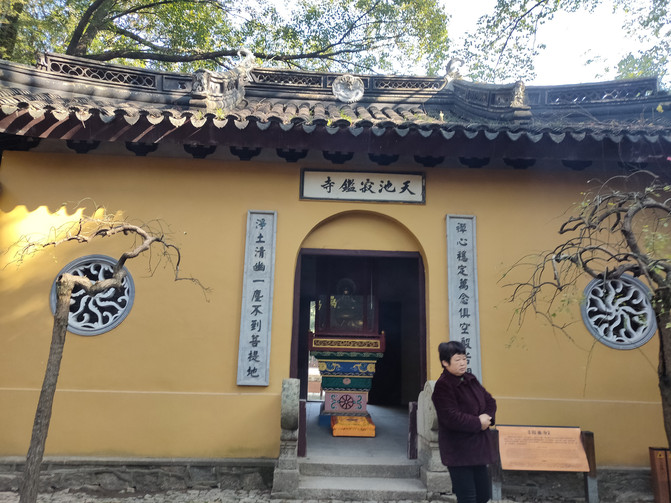



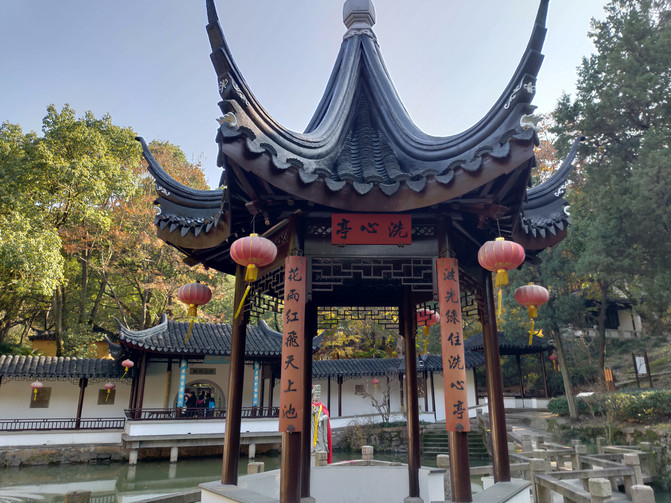
















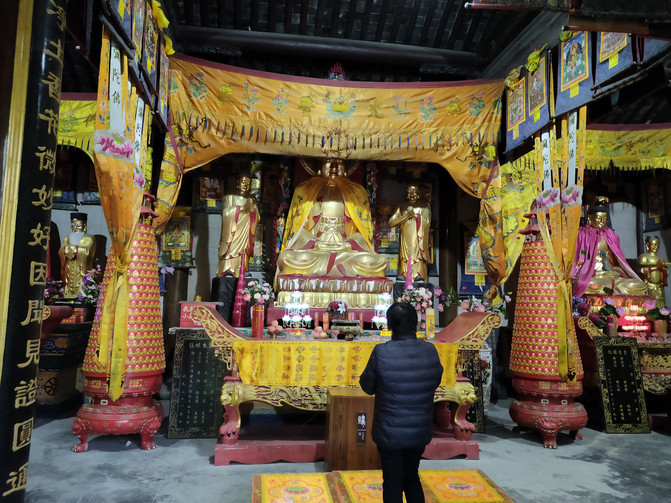


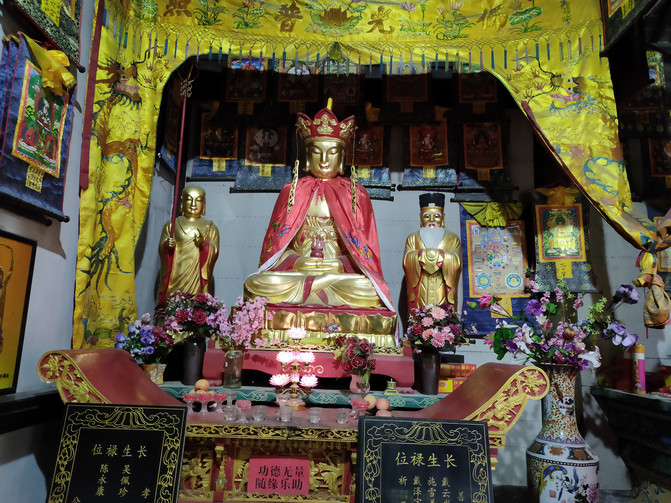
















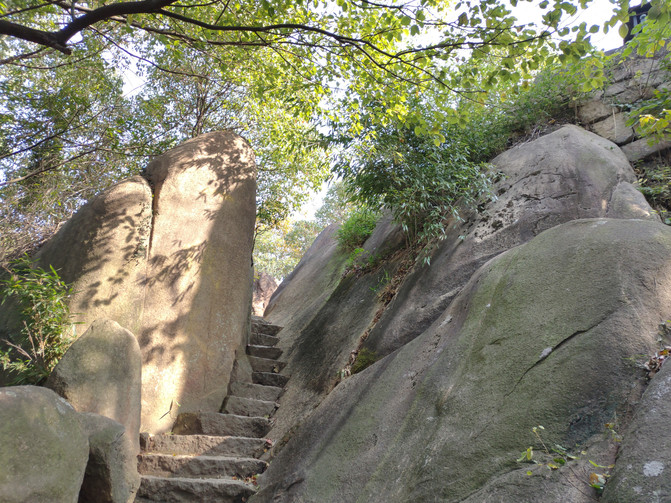



Previous Article:There is a kind of "chance encounter" called "reunion after a long separation"--a three-day tour in Suzhou
Next Article:Misty Peak, the highest peak in Taihu Lake-Suzhou 3rd (6)
